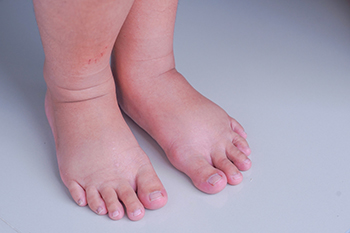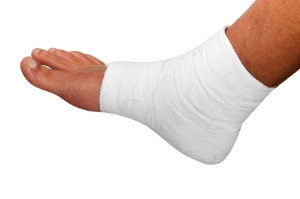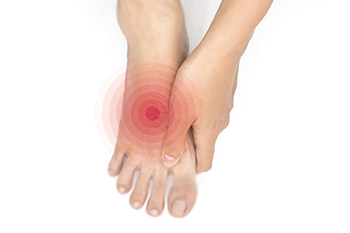Items filtered by date: August 2023
Dealing With Overlapping Toes

An overlapping toe, whether in adults or newborns, is a common condition with varying causes. In adults, overlapping toes can result from heredity, ill fitting shoes, and different forms of arthritis, including rheumatoid. Biomechanics, such as overpronation or tight calf muscles are other possible causes. Foot conditions, such as bunions, flat feet, hammer toes, and high arches, may cause overlapping toes to develop. Factors such as age and foot injuries can worsen this condition. Overlapping toes can also affect newborns, typically involving the pinky toe overlapping the fourth toe. Genetics and fetal position in the womb can contribute to this condition too. Complications of overlapping toes include pain, corns, calluses, bursitis, and metatarsalgia. Prompt treatment is essential to prevent these complications and to ensure proper alignment of the toes. Non surgical measures include proper shoe fitting, toe separators, and maintaining a healthy body weight. In some cases, surgery may be an option. If you are experiencing overlapping toes, it is suggested that you make an appointment with a podiatrist for an accurate diagnosis and personalized treatment plan.
Toe pain can disrupt your daily activities. If you have any concerns, contact Kimberly Woodard, DPM of Pinnacle Foot and Ankle Centers, LLC . Our doctor can provide the care you need to keep you pain-free and on your feet.
What Causes Toe Pain?
Most severe toe pain is caused due to a sports injury, trauma from dropping something heavy on the toe, or bumping into something rigid. Other problems can develop over time for various reasons.
Toe pain can be caused by one or more ailments. The most common include:
- Trauma
- Sports injury
- Wearing shoes that are too tight
- Arthritis
- Gout
- Corns and calluses
- Hammertoe
- Bunions
- Blisters
- Ingrown toenails
- Sprains
- Fractures (broken bones)
- Dislocations
When to See a Podiatrist
- Severe pain
- Persistent pain that lasts more than a week
- Signs of infection
- Continued swelling
- Pain that prevents walking
Diagnosis
In many cases the cause of toe pain is obvious, but in others, a podiatrist may want to use more advanced methods to determine the problem. These can range from simple visual inspections and sensation tests to X-rays and MRI scans. Prior medical history, family medical history, and any recent physical traumatic events will all be taken into consideration for a proper diagnosis.
Treatment
Treatments for toe pain and injuries vary and may include shoe inserts, padding, taping, medicines, injections, and in some cases, surgery. If you believe that you have broken a toe, please see a podiatrist as soon as possible.
If you have any questions please feel free to contact our office located in Port St. Lucie, FL . We offer the newest diagnostic tools and technology to treat your foot and ankle needs.
Heel Pain Can Be Treated!
Exploring Causes of Swollen Feet

Swollen feet, an uncomfortable and often puzzling issue, can cast a shadow over daily activities. The causes behind this condition can be as diverse as they are unexpected. Prolonged periods of standing or sitting, especially in hot weather, can lead to fluid accumulation in the lower extremities. Pregnancy, with its hormonal shifts and increased pressure on blood vessels, is a common culprit. Health conditions such as heart, kidney, or liver problems can disrupt the body's fluid balance, resulting in swelling. Injuries, infections, and certain medications can also contribute to swelling. Recognizing swollen feet is relatively simple, which is easy to notice as the feet are puffy and tight. Additionally, there can be an indentation in the skin, indicating the feet are swollen. Understanding the underlying triggers empowers individuals to make informed choices, seek medical guidance from a podiatrist, and embrace measures that foster foot health and overall well-being. If you have swollen feet, it is strongly suggested that you speak with a podiatrist who can offer effective treatment methods.
Swollen feet can be a sign of an underlying condition. If you have any concerns, contact Kimberly Woodard, DPM of Pinnacle Foot and Ankle Centers, LLC . Our doctor can provide the care you need to keep you pain-free and on your feet.
Swollen feet are a common ailment among pregnant women and people who stand or sit for extended periods. Aging may increase the possibility of swollen feet and patients who are obese often notice when their feet are swelling too. There may be medical reasons why swollen feet occur:
- Phlebitis - A condition that causes the veins to become inflamed and can also cause leg pain.
- Liver disease - This may lead to low blood levels of albumin which is a protein. This can cause fluid in the blood to pass into the tissues and several areas of the body can become swollen.
- Heart failure - When the heart doesn’t pump properly the blood that is normally pumped back to the heart can pool in the veins of the legs causing swollen feet.
- Kidney disease - One of the main functions of the kidneys is releasing excess fluid in the body. This type of condition can make it difficult for the kidneys to function properly, and as a result the feet may become swollen.
- Deep-vein thrombosis (DVT)- This is a serious condition where blood clots form in the veins of the legs. They can block the return of blood from the legs to the heart which may cause the feet to swell. It is important to be treated by a podiatrist if this condition is present.
Swollen feet can also be caused by bone and tendon conditions, including fractures, arthritis, and tendinitis. Additionally, there may be skin and toenail conditions and an infection may cause the feet to swell. Patients who take medicine to treat high blood pressure may be prone to getting swollen feet.
Many patients elevate their feet to help relieve the swelling and this is generally a temporary remedy. When a podiatrist is consulted the reason behind the swelling can be uncovered and subsequently treated.
If you have any questions please feel free to contact our office located in Port St. Lucie, FL . We offer the newest diagnostic tools and technology to treat your foot and ankle needs.
All About Ankle Ulcers

Ankle ulcers are open sores on the skin. They are slow to heal, and they can keep returning. The three types of ankle ulcers are venous stasis, diabetic, and arterial ulcers. Venous stasis ulcers are the most common, primarily affecting the ankles. They result from venous hypertension or chronic venous insufficiency, leading to decreased blood flow and oxygen to the tissue and causing damage and ulcer formation. Risk factors include leg swelling, blood clots, varicose veins, inflammatory diseases, and a family history of ulcers. Symptoms may include pain, burning, itching, redness, and the skin may be swollen or discolored. Diagnosis involves a medical history, symptom analysis, and possible tissue sampling. Treatments include compression therapy, medication, and wound care. It is important to keep the ulcer clean and change the dressing as instructed. Prevention of such ulcers involves leg elevation, limiting prolonged standing or sitting, and maintenance of good overall health. If you suffer from ankle ulcers, it is strongly suggested that you make an appointment with a podiatrist for a proper diagnosis and prompt treatment.
Wound care is an important part in dealing with diabetes. If you have diabetes and a foot wound or would like more information about wound care for diabetics, consult with Kimberly Woodard, DPM from Pinnacle Foot and Ankle Centers, LLC . Our doctor will assess your condition and provide you with quality foot and ankle treatment.
What Is Wound Care?
Wound care is the practice of taking proper care of a wound. This can range from the smallest to the largest of wounds. While everyone can benefit from proper wound care, it is much more important for diabetics. Diabetics often suffer from poor blood circulation which causes wounds to heal much slower than they would in a non-diabetic.
What Is the Importance of Wound Care?
While it may not seem apparent with small ulcers on the foot, for diabetics, any size ulcer can become infected. Diabetics often also suffer from neuropathy, or nerve loss. This means they might not even feel when they have an ulcer on their foot. If the wound becomes severely infected, amputation may be necessary. Therefore, it is of the upmost importance to properly care for any and all foot wounds.
How to Care for Wounds
The best way to care for foot wounds is to prevent them. For diabetics, this means daily inspections of the feet for any signs of abnormalities or ulcers. It is also recommended to see a podiatrist several times a year for a foot inspection. If you do have an ulcer, run the wound under water to clear dirt from the wound; then apply antibiotic ointment to the wound and cover with a bandage. Bandages should be changed daily and keeping pressure off the wound is smart. It is advised to see a podiatrist, who can keep an eye on it.
If you have any questions, please feel free to contact our office located in Port St. Lucie, FL . We offer the newest diagnostic and treatment technologies for all your foot care needs.
Essential Foot Protection Tips While Working

Your feet play a crucial role in your daily activities, especially at work. Whether you're in a physically demanding job or spend hours at a desk, it's essential to prioritize foot protection. It is beneficial to invest in high-quality, sturdy footwear that provides ample support and fits well. Steel-toed boots are essential to wear while working in hazardous environments. Many people choose to wear customized orthotic inserts which can enhance comfort, reduce fatigue, and prevent injuries by providing additional arch support. Additionally, be aware of slippery surfaces, sharp objects, or potential hazards that could lead to accidents. If your job involves standing or walking for long periods, taking regular breaks can help the feet to rest and avoid discomfort. Performing foot and ankle exercises can strengthen the muscles and increase flexibility, reducing the risk of strains and sprains. By prioritizing foot protection, you can maintain your overall well-being and ensure optimal performance throughout your workday. If you would like more information about foot protection during the work day, it is suggested that you consult with a podiatrist who can provide you with useful tips.
While working on the feet, it is important to take the proper care of them. For more information about working on your feet, contact Kimberly Woodard, DPM from Pinnacle Foot and Ankle Centers, LLC . Our doctor will treat your foot and ankle needs.
Working on Your Feet
Standing on your feet for long periods of time can cause stress and pain in your feet. Your whole body may experience change in terms of posture, back pain, bunions, callouses and or plantar warts. There are ways to avoid these conditions with proper foot care, smart choices and correct posture.
Positive Changes
Negative heeled shoe – Choosing this shoe type places the heel slightly lower than the ball of the foot. These are great for overall foot health. Find shoes that fit you correctly.
Go barefoot – Our feet were not designed to be enclosed for all hours of the day. Try to periodically expose your feet to air.
Eliminate Pain
Foot Exercises – Performing simple exercises, incorporating yoga and doing stretches are beneficial. This will allow increased blood flow to the area and muscles of the foot.
Achilles tendon – Stretching the foot out flat on the floor will relax the calf muscles and tendon. These exercises can be performed almost anywhere. Make sure you add these exercises to your daily regimen.
With a little bit of this information and knowing more about foot health, you will notice changes. Foot stretches and proper footwear will help with pain and prevent further issues.
If you have any questions please feel free to contact our office located in Port St. Lucie, FL . We offer the newest diagnostic and treatment technologies for all your foot and ankle needs.
Foot Care Tips for Diabetics

A common side effect of diabetes is the tendency to develop peripheral neuropathy and circulation problems. Both are the result of long-term high blood sugar levels. As a result, the feet may become numb and the ability to heal may be impeded. These consequences can lead to the development of foot ulcers. Because the feet become numb, cuts and cracks in the skin may not be felt, and because of arterial disease that constricts the blood vessels to the extremities, healing takes longer. For those reasons, a daily routine of foot care is essential to anyone with diabetes. Medical professionals, such as podiatrists, suggest that washing and drying the feet daily is a must. Examining the feet for sores or cuts should happen daily. Keeping the feet elevated as often as possible is also a good idea. Experts also recommend changing to footwear that fits well, and wearing socks can help to protect the feet. For treatment of foot problems related to diabetes, it is suggested that you make regular visits to a podiatrist.
Diabetic foot care is important in preventing foot ailments such as ulcers. If you are suffering from diabetes or have any other concerns about your feet, contact Kimberly Woodard, DPM from Pinnacle Foot and Ankle Centers, LLC . Our doctor can provide the care you need to keep you pain-free and on your feet.
Diabetic Foot Care
Diabetes affects millions of people every year. The condition can damage blood vessels in many parts of the body, especially the feet. Because of this, taking care of your feet is essential if you have diabetes, and having a podiatrist help monitor your foot health is highly recommended.
The Importance of Caring for Your Feet
- Routinely inspect your feet for bruises or sores.
- Wear socks that fit your feet comfortably.
- Wear comfortable shoes that provide adequate support.
Patients with diabetes should have their doctor monitor their blood levels, as blood sugar levels play such a huge role in diabetic care. Monitoring these levels on a regular basis is highly advised.
It is always best to inform your healthcare professional of any concerns you may have regarding your feet, especially for diabetic patients. Early treatment and routine foot examinations are keys to maintaining proper health, especially because severe complications can arise if proper treatment is not applied.
If you have any questions please feel free to contact our office located in Port St. Lucie, FL . We offer the newest diagnostic and treatment technologies for all your foot and ankle needs.

